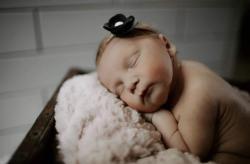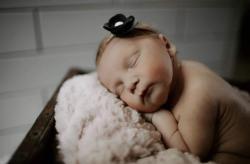

Our beautiful baby girl was born on August 31st! She was the most beautiful blue-eyed, red haired bundle I had ever .jpg) seen. Her dad and I were in-love and happier than we had ever been.
seen. Her dad and I were in-love and happier than we had ever been.
It wasn’t long after coming home that we noticed Henderson exhibited some unusual behaviors. She would often turn her head to the side, mouth open, and body stretched out. She had some initial feeding difficulties that would be diagnosed as dysphasia following a swallow study. Her quirks of twisting were suspected to be due to reflux.
Following her initial quirks we started to collect videos of the different behaviors we observed. We saw lots of nystagmus, moments of blank stares, arm shaking, and even loss of movement in her arms. Each of these episodes, in the beginning, were fleeting and made me feel as if I was being an anxious first-time mom.
It wasn’t until June of 2020 that our journey of trying to uncover what was really going on started. On June 27, Henderson and I had an uncharacteristically busy day. We had come home for the day, and I noticed her left arm trembling. We had noticed this before and questioned low-blood sugar, dehydration, etc. We tried many different things to console her. It was then that we experienced head convulsions followed by extreme lethargy. We rushed Henderson to the local Pediatric ER.
Upon admitting us, Henderson was monitored via EEG for 36 hours. It was at this time they dismissed this “seizure like episode” as a fluke. However, they noted that Henderson had what they call “background slowing” and would need to get an MRI. We were assured that likely, nothing would be found.
The MRI showed a Venous Anamoly on Henderson’s left parietal lobe. We were told these usually cause no issues, but our neurologist believed that could be causing Henderson’s limb weakness. Our neurologist asked to follow up in 3 months.
However, it was at this time, Henderson’s episodes amplified. She was experiencing longer durations of not using an arm. The weakness also started to cause her mouth to droop. After a 3 day stretch of not using her arm, Henderson was admitted once again. This time they performed and MRI of her spinal cord and performed different muscular and autoimmune panels to rule out a whole host of diagnoses. We were sent home with the diagnosis of “maybe she will outgrow it”. .jpg)
It was at this time, I stumbled upon “Alternating Hemiplegia of Childhood”. The description of episodes/symptoms fit Henderson’s behaviors. I reached out to our Neurologist and was dismissed. He stated, “that would be really weird because it is so rare”.
It wasn’t long after this stay that she would have more spells that looked like seizures. After a video sent to our neurologist, he believed she was experiencing partial seizures and prescribed Keppra. Keppra helped our frequency, but because she was still having episodes, an extended EEG was ordered.
January 20, 2021 we were admitted for a five day EEG. Throughout this stay it was determined that Henderson’s “episodes” were not seizures. We were told her background slowing was still present, but improved. They told us she was not neuro-typical, and they were concerned she had a genetic cause for her symptoms. The doctor ran a genetic panel, which was set to return in a couple months. The attending sent us home on Keppra and with a follow-up with our primary neurologist.
On my way home, Henderson’s neurologist called. He had all positive things to say. He believed that these episodes weren’t harming her brain. He reiterated that we were able to capture the episodes, and there was no electrical (seizure) activity captured. He said he believed it was behavioral. He thought she would outgrow it. He said we would follow up with a movement neurologist in June, but would stop Keppra in the meantime. During this call he also said he did not believe her to have any genetic links. I went home feeling cautious, but hopeful that he was right, and she would outgrow this.
The month following was a month littered with episodes for Henderson. Then four weeks after speaking with our neurologist, Henderson had another major event. This event left her limp for 5 minutes. To say we were terrified once again, was an understatement. We felt not heard and not taken seriously. We made another trip to our local pediatric ER. Once again we were dismissed and told they would see us in June. However, the ER nurse knew that something was not right. She told us to keep sending messages and updating them.
The next day, Henderson was unable to chew her food and struggled swallowing accompanied by her usual limb weakness. Another message to our doctor resulted in an expedited visit with the movement neurologist.
Within 15 minutes of seeing our new neurologist she spoke the words I knew to be true, but feared the most. She unofficially diagnosed Henderson with Alternating Hemiplegia of Childhood awaiting a genome sequencing. 
On April 15, 2021 we received a call confirming our biggest fear. Henderson did, in fact, have a genetic mutation on ATP1A3 causing her to have Alternating Hemiplegia of Childhood. The hardest part of the news is the fact that there is not a cure YET, and the “what will be” is so unknown.
We are so in love with our baby girl, and want nothing more than to give her the best chance at conquering this evil disease. That is why we believe in gene therapy and the potential for a cure!
The Race to END AHC is on! For over 25 years the AHC Foundation has been in the race to treat or cure AHC for all our AHC kids. It has been a long race, and the foundation has covered much ground by taking many steps toward that goal.
Through research, education and family support, we have ONE MISSION: END AHC
Through these three pillars of our mission, the AHC Foundation works to provide the community support and hope as we all move through this journey. Funding RESEARCH from small studies to gene discovery, to collaboration on landmark gene therapy that holds much potential; providing EDUCATIONAL resources to families through support groups, introductions to physicians, and our website; SUPPORTING FAMILIES through our support group, biennial family meetings, and availability of volunteers for crisis; are all ways the AHC Foundation works to END AHC.
Join us in fundrasing to continue to provide resources to families, fund research with high potential, and raise awareness to rare disease.
| Henderson's Story | ||
|
Raised: $669.16 |
||
| Lauren Schweizer | ||
|
Raised: $309.90 |
||
| Anthony Giannell | ||
|
Raised: $0.00 |
||
| David Lehman | ||
|
Raised: $0.00 |
||
| David Lehman | ||
|
Raised: $0.00 |
||
| Michelle Martell | ||
|
Raised: $0.00 |
||


